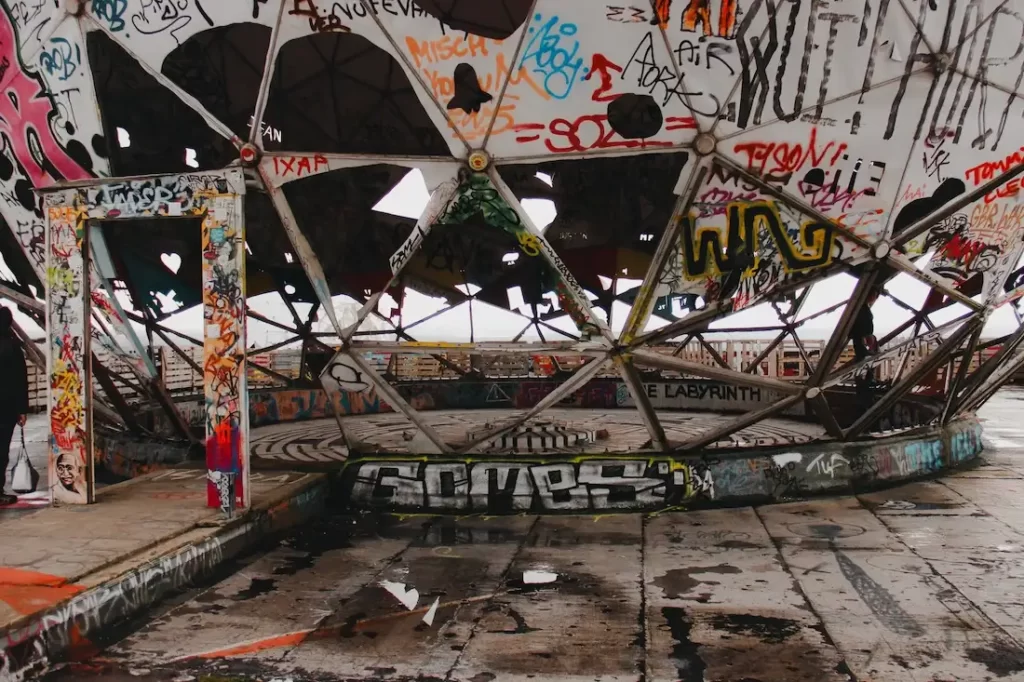Let’s embark on an exploration of Berlin Street Art, a city renowned for its artistic expression.
Berlin is ugly. Gray, huge, and filled with bizarre architectural buildings, the German capital differs from what one expects of a European city. However, it has its charm. And it lies precisely in the contrasts between the buildings, the history that emanates from the streets, and the effervescent cultural life that makes it one of the most exciting cities you will ever set foot in.
This scenario was perfect for the proliferation of street art by renowned artists, such as Os Gêmeos, Blu, and Banksy, as well as the illustrious anonymous artists who left their mark and message on the walls of Berlin.
I spent ten days in the city exploring its alternative side, and the murals and graffiti play an essential role in this scene. These are some of the best places to see street art in Berlin.

Suggested Read:
• Best Alternative and Unusual Museums to Visit in Berlin
• Best Lakes to Swim in Berlin
Top Places to See Street Art in Berlin
Hiring a street art tour is an absolute must-do if you’re looking to dive deep into Berlin’s street art scene. Berlin offers an array of street art tours that will show you the hidden stories and talents behind its colorful walls. Click here and find out more!
Fun fact: You will see many collages on the walls of Berlin. This is because, unlike graffiti, they are not considered an infraction and are quick to put up and hard to remove.
1. Haus Schwarzenberg alley
The alley of Haus Schwarzenberg, also known as Hackescher Hofe, is a place where artists are allowed to showcase their creativity by painting the walls. Some artworks are permanent, while others are temporary and replaced by new ones after a while.
As you step into this narrow slice of Berlin, you’ll feel like you’ve walked into a living, breathing art gallery. The alley’s got a strict ‘cool art only’ policy. Artists who are interested in painting the walls need to contact the owner of the alley first. The owner approves and assigns a space for the artwork. This ensures that every scribble and spraypaint stroke adds something unique to the alley’s vibe.
But Haus Schwarzenberg isn’t just about looking cool for the ‘gram. Nope, it’s also a place for awesome cultural events and carries a chunk of Berlin’s history and soul. After the city shook off the Berlin Wall’s shadow, this alley emerged as a symbol of freedom, creativity, and unity. It’s where Berlin’s turbulent history and hip, artsy present shake hands and say, “Let’s make something awesome together.”
2. Spree River Banks
A mural greets the refugees who have recently arrived in the city. Just behind it, a large graffiti protests against the real estate project on the Spree River banks. The attractive prices and proximity to train stations have grabbed the attention of investors and speculators, which has outraged Berliners.
Some people believe that this particular investment will change the nature of the neighborhood and turn public areas that are currently accessible to everyone, such as the riverfront and segments of the Berlin Wall, into private spaces. This may lead to an increase in prices for the residents and initiate a gentrification process.
One of the most striking features of the Spree Banks is the sheer diversity of the artwork. You’ll find everything from large-scale murals telling stories of Berlin’s past, present, and future to quirky sculptures that might make you double-take (yes, that’s a giant pink rabbit over there!).
Of course, the Spree’s art scene isn’t just for the daytime. As the sun sets, the riverbanks take on a new life. Think of impromptu music gigs, open-air film screenings, and art installations. It’s the perfect backdrop for those summer evenings when you want to chill and soak in Berlin’s unique vibe.
3. East Side Gallery

A 1.3-kilometer stretch of the Berlin Wall that was once a symbol of division and oppression now stands proudly as the longest open-air gallery in the world. The East Side Gallery is like a bridge between two worlds – the grim past of a divided Berlin and the hopeful, vibrant present of a unified city.
As you walk along this historic canvas, you’re taken on a journey through over 100 murals painted by artists from all around the globe.
One of the most iconic images – perhaps you’ve seen it in photos – is the “Fraternal Kiss,” depicting Soviet leader Leonid Brezhnev and East German leader Erich Honecker kissing. It’s a powerful, somewhat cheeky representation of the political realities of the time, infused with a hint of irony.
Suggested Read: Mauerpark: The Best Flea Market in Berlin

The beauty of this place isn’t just in the art itself but also in its accessibility. Open to all, it’s a democratic space where art isn’t confined to hushed galleries and expensive tickets.
Yet, the East Side Gallery is also a place of controversy and change. It faces threats from urban development and vandalism, reminding us that history, no matter how brightly painted, is always vulnerable. Visiting the gallery becomes an act of participation in this ongoing narrative, a way to connect with and preserve our collective history.
Feeling creative? What about doing a Street Art Workshop at the Berlin Wall?
4. Teufelsberg

Teufelsberg is one of the many abandoned buildings in the city that serve as an art gallery for graffiti artists. In the past, the building was used as an American espionage point against the Russians.
The name means ‘Devil’s Mountain,’ but it isn’t a natural hill. It’s an artificial mound built atop the rubble of a war-torn Berlin. Underneath its grassy exterior lies the ghost of a Nazi military-technical college.
The Americans plopped a listening station on this hill during the Cold War. Giant, golf ball-like radomes (weird big domes) used to eavesdrop on East Berlin and beyond. It’s like something straight out of a spy novel!
Fast forward to today, and Teufelsberg has morphed into a graffiti paradise. The abandoned structures are now canvases for some of Berlin’s most vibrant street art.
The views from Teufelsberg are nothing short of spectacular. From its peak, Berlin unfolds before you. It’s the perfect spot for some contemplation or, let’s be honest, a killer photo with a backdrop that’s got more stories than your average skyline.

5. Squats – Occupied Houses
The occupied houses also serve as a canvas for the city’s street artists who scream messages of resistance, community, and defiance.
Occupied houses, or “Squats,” have a storied history in Berlin. Post-reunification, the city was dotted with abandoned buildings. Rather than let them decay, a vibrant community of artists, activists, and free spirits breathed new life into these spaces.
You’ll stumble upon these urban resistance spots as you wander through neighborhoods like Kreuzberg and Friedrichshain. They’re plastered with murals, graffiti, and installations that are as much about beauty as they are about making bold statements.
Each occupied house is unique, but they all share a common thread – they’re a thumb in the eye of convention and gentrification. In a city grappling with rapid development and soaring rents, these houses stand as bastions of resistance. They’re a reminder of Berlin’s edgy, alternative soul that refuses to be polished away.
The art on these buildings often reflects the ethos of their inhabitants. It’s raw, unapologetic, and thought-provoking. You’ll see everything from intricate murals depicting political and social issues to spontaneous graffiti that captures the anarchic spirit of the residents.
These houses often double as cultural centers, hosting many events – underground concerts, art exhibitions, workshops, and more.
Visiting these spaces isn’t just about seeing another side of Berlin’s art scene; it’s a glimpse into a world where art isn’t a commodity but a tool for change, a voice for the voiceless, and a symbol of unity in the face of division.
However, tread with respect. These aren’t tourist attractions but people’s homes and safe spaces. Their existence is often precarious, constantly under threat from authorities and developers. Each visit should be mindful of the delicate balance these communities maintain.
For instance, this one, on Rigaerstrasse, has been attacked by local politicians, who want to remove the residents at any cost.
6. Mehringdamm
Mehringdamm, nestled in the bustling district of Kreuzberg, is not just another street in Berlin; it’s a living, breathing gallery of street art.
The walls are adorned with everything from large-scale murals that make you stop in your tracks to whimsical stencils and tags that give you a glimpse into the minds of Berlin’s most creative souls.
The beauty of Mehringdamm’s street art lies in its variety. You’ll find works by internationally renowned artists alongside pieces by local talents, each adding their unique voice to the urban tapestry. From political and social commentary to abstract and surreal imaginings, the art here is as diverse as the people who create it and the audiences who admire it.
This area is a melting pot of cultures, cuisines, and communities, and the art reflects this beautiful chaos.
You’ll also discover that Mehringdamm is a hotspot for street art tours, where guides share the stories behind the art and the artists. It’s a fantastic way to delve deeper into the meaning and significance of the works you see and understand street art’s role in Berlin’s cultural landscape.
Explore the city with the Berlin Welcome Card
The Berlin Welcome Card is your budget-friendly buddy, offering a treasure trove of discounts at over 200 attractions. Museums, galleries, tours, and even some restaurants. Learn more!
This is your all-access pass to the city’s endless attractions, tailored to your travel needs and packed with perks.
Unlimited Travel Across the City: The Berlin Welcome Card is your passport to unlimited travel. It covers all public transportation in the city, including buses, trams, U-Bahn (subway), and S-Bahn (city rail). Say goodbye to the hassle of buying individual tickets and hello to seamless city exploration!
Choose Your Perfect Match: The card comes in several options, ensuring there’s a perfect fit for every type of traveler:
- 48-hour Card: Ideal for short stays, diving into the heart of Berlin.
- 72-hour Card: Perfect for a long weekend, balancing sightseeing with leisure.
- 4-6 day Cards: These are great for an extended exploration, allowing you to soak in Berlin at your own pace.
Discounts and Deals: The card is a treasure chest of savings, offering discounts at over 200 attractions, including museums, tours, and select restaurants. This means more experiences for less!
Pricing: The cost of the Berlin Welcome Card varies based on duration and coverage area:
- 48-hour AB Zone: €23 (ideal for central Berlin).
- 48-hour ABC Zone: €28 (includes travel to Potsdam and Berlin Schönefeld Airport).
- Prices increase incrementally for the 72-hour and 4-6 day options.
Additional Perks: Some Berlin Welcome Card variants include special additions like free entry to the Berlin TV Tower or a city river cruise.
Family-Friendly: Traveling with family? The card covers children up to a certain age for free, making it a great option for family trips.
Free Guidebook: Each card comes with a guidebook brimming with insider tips and information to help you uncover Berlin’s hidden gems.
Editor of Yes, Summer! I am a Brazilian journalist, writer, and digital nomad. I have been traveling the world, telling stories, and tasting local beers since 2010. I am the co-founder of 360meridianos, a reference in travel writing in Brazil, and author of the newsletter Migraciones. On social media, I'm always reachable at @natybecattini.
